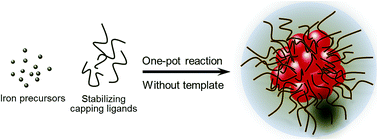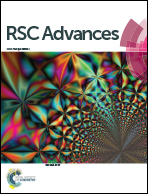Facile synthesis of superparamagnetic magnetite nanoflowers and their applications in cellular imaging†
Abstract
Clustering of biocompatible magnetite nanocrystals into secondary structures not only allows the combination of properties of individual crystals but also creates new collective properties by taking advantage of their electromagnetic interactions. In this work, we describe the synthesis of water-soluble biocompatible superparamagnetic magnetite nanoflowers (MNFs) by thermal decomposition of iron oleate with polyethylene glycol diacid as a capping ligand. These nanoflowers, dispersed in water at physiological pH, present particularly interesting magnetic properties. The structure and morphology of the MNFs were characterized by X-ray diffraction and transmission electron microscopy. In addition, confocal fluorescence microscopy was used to study the cellular uptake of the dye-functionalized nanoflowers in vitro. The combination of superparamagnetism, high magnetization, and high stability makes these MNFs ideal candidates for biomedical applications.


 Please wait while we load your content...
Please wait while we load your content...